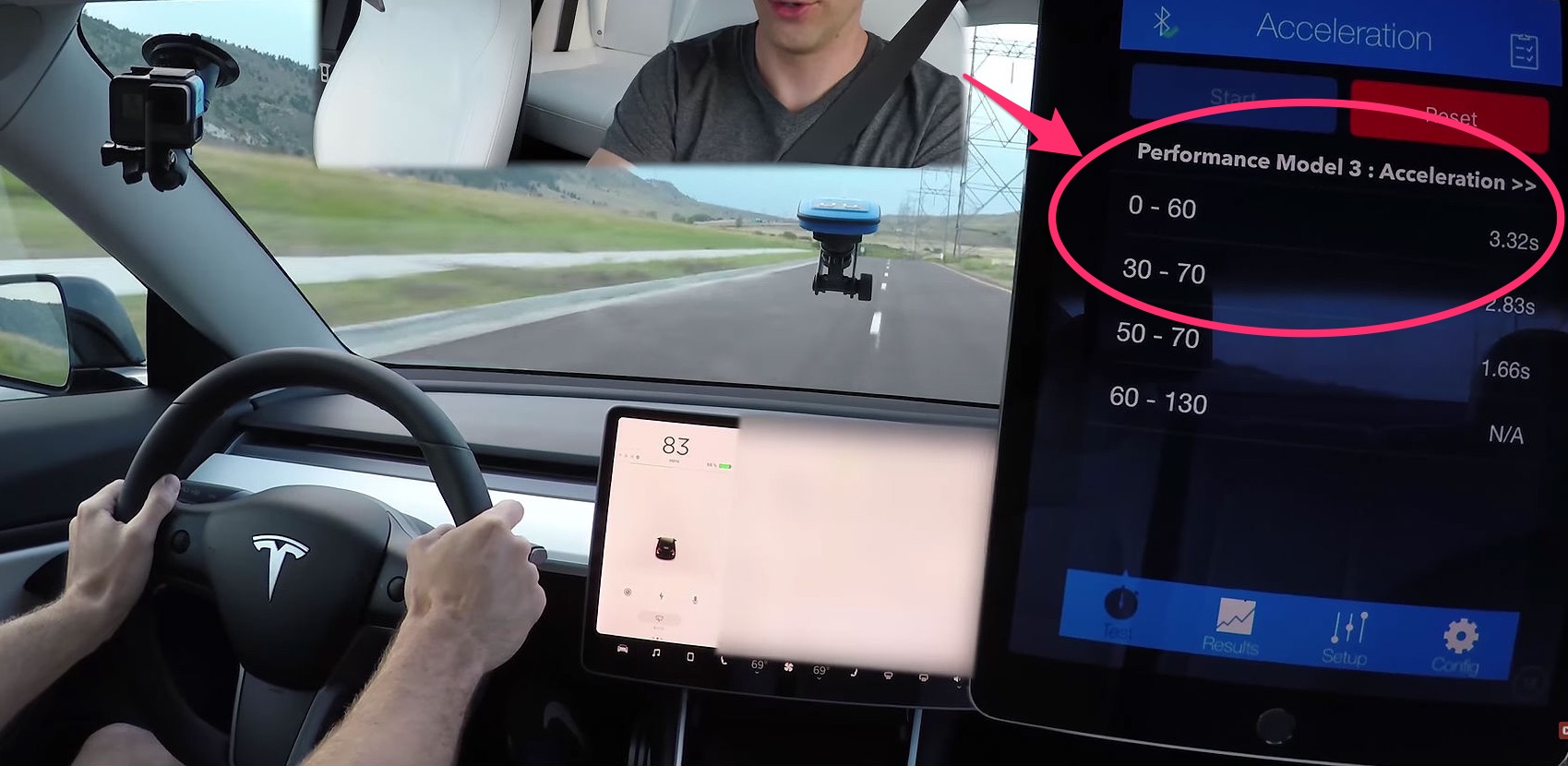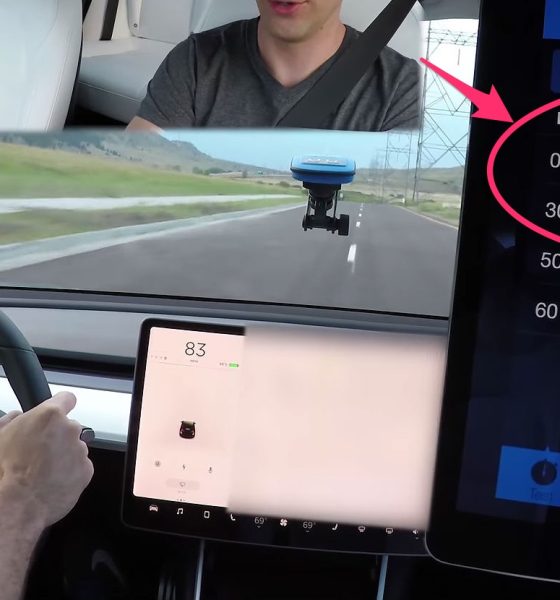

News
Tesla Model 3 Performance nails consistent 3.3 second 0-60 mph runs in back-to-back tests
Tesla lists its Dual Motor Model 3 Performance with a 0-60 mph time of 3.5 seconds, but as acceleration tests of the car seem to suggest, the vehicle is actually faster than Tesla’s estimates. This was demonstrated recently by Tesla owner-enthusiast Erik Strait, better known as the host of YouTube’s DÆrik channel, as he performed back-to-back acceleration tests of the Model 3 Performance using a VBOX data logger.
The first VBOX stats of the Model 3 Performance’s 0-60 mph time was posted recently, but no video of the actual run was taken as per request of the car’s owner. A brief 0-60 run recorded with Dragy was posted a few days ago, but the vehicle in that video was equipped with Aero Wheels, which are optimized for range, not performance. Erik’s test was quite a bit different since the Model 3 Performance he drove was equipped with 20″ Performance Wheels and Michelin Pilot Sport 4S summer tires, which are part of Tesla’s $5,000 Performance Package.
Consistent with VBOX data shared by fellow Tesla owner-enthusiast Eli of My Tesla Adventure, DÆrik‘s acceleration test featured a consistent 0-60 mph time of 3.3 seconds. That’s 0.2 seconds faster than Tesla’s official performance listings for the vehicle.
A 3.3-second 0-60 mph time for the Model 3 Performance was actually teased by Elon Musk on Twitter, with the CEO stating that the electric car could have better acceleration if it gets fitted with stickier and thicker tires at the rear. Musk noted that thicker rear tires for the Model 3 Performance would make it possible to lower the vehicle’s 0-60 mph time to just 3.3 seconds. Erik’s recently uploaded video on YouTube is proof that 3.3 seconds is possible even when the vehicle is unmodified.
The Model 3 Performance has so far been getting rave reviews from veteran auto journalists. Dan Neil from the Wall Street Journal described the car as a “magnificent” piece of auto engineering that is “representative of the next step in the history of autos.” Kim Reynolds of MotorTrend, whose test drive of the vehicle was highlighted by a brief sprint on a freeway on-ramp, stated that “in maybe 120 wheel revolutions, a high-performance hierarchy has been rattled.” The auto veteran also stated that the “European marques perennially atop the sport sedan podium are about to have trapdoors release beneath them” with the arrival of the Model 3.
The Performance Model 3 might look practically identical to the car’s lower-specced variants, but the vehicle does have several tricks up its sleeve. Among these is a unique “Track Mode” beta feature exclusive to the Model 3 Performance (at least for now). In a statement to Road and Track, Michael Neumeyer, Manager of Chassis Controls for Tesla, stated that the Model 3 Performance’s Track Mode differs slightly from comparable features in other vehicles, which usually involve the disabling of traction control systems.
“Our Track Mode doesn’t disable features, it adds them,” Neumeyer said.
Tesla’s Track Mode is a mixture of tweaks and in-house programming that makes adjustments to the vehicle’s settings, including its dynamic control and regenerative braking. With the beta feature turned on, the Model 3 Performance becomes a car capable of maneuvers that are invaluable on the track, such as drifting and sharp changes in direction. The Model 3 Performance’s motors and battery use cooling circuits that are independent but linked as well. This means that as one component heats up, the car’s system shifts cooling capacity where it’s needed. With this approach, the Model 3 Performance becomes immune to the total performance shutdowns that happen in vehicles like the Model S P100D when temperatures spike.
Watch DÆrik‘s VBOX-recorded Model 3 Performance 0-60 mph run in the video below.
https://youtu.be/8P8DZKFUw3k

Elon Musk
Elon Musk and Tesla AI Director share insights after empty driver seat Robotaxi rides
The executives’ unoccupied tests hint at the rapid progress of Tesla’s unsupervised Robotaxi efforts.

Tesla CEO Elon Musk and AI Director Ashok Elluswamy celebrated Christmas Eve by sharing personal experiences with Robotaxi vehicles that had no safety monitor or occupant in the driver’s seat. Musk described the system’s “perfect driving” around Austin, while Elluswamy posted video from the back seat, calling it “an amazing experience.”
The executives’ unoccupied tests hint at the rapid progress of Tesla’s unsupervised Robotaxi efforts.
Elon and Ashok’s firsthand Robotaxi insights
Prior to Musk and the Tesla AI Director’s posts, sightings of unmanned Teslas navigating public roads were widely shared on social media. One such vehicle was spotted in Austin, Texas, which Elon Musk acknowleged by stating that “Testing is underway with no occupants in the car.”
Based on his Christmas Eve post, Musk seemed to have tested an unmanned Tesla himself. “A Tesla with no safety monitor in the car and me sitting in the passenger seat took me all around Austin on Sunday with perfect driving,” Musk wrote in his post.
Elluswamy responded with a 2-minute video showing himself in the rear of an unmanned Tesla. The video featured the vehicle’s empty front seats, as well as its smooth handling through real-world traffic. He captioned his video with the words, “It’s an amazing experience!”
Towards Unsupervised operations
During an xAI Hackathon earlier this month, Elon Musk mentioned that Tesla owed be removing Safety Monitors from its Robotaxis in Austin in just three weeks. “Unsupervised is pretty much solved at this point. So there will be Tesla Robotaxis operating in Austin with no one in them. Not even anyone in the passenger seat in about three weeks,” he said. Musk echoed similar estimates at the 2025 Annual Shareholder Meeting and the Q3 2025 earnings call.
Considering the insights that were posted Musk and Elluswamy, it does appear that Tesla is working hard towards operating its Robotaxis with no safety monitors. This is quite impressive considering that the service was launched just earlier this year.
Elon Musk
Starlink passes 9 million active customers just weeks after hitting 8 million
The milestone highlights the accelerating growth of Starlink, which has now been adding over 20,000 new users per day.

SpaceX’s Starlink satellite internet service has continued its rapid global expansion, surpassing 9 million active customers just weeks after crossing the 8 million mark.
The milestone highlights the accelerating growth of Starlink, which has now been adding over 20,000 new users per day.
9 million customers
In a post on X, SpaceX stated that Starlink now serves over 9 million active users across 155 countries, territories, and markets. The company reached 8 million customers in early November, meaning it added roughly 1 million subscribers in under seven weeks, or about 21,275 new users on average per day.
“Starlink is connecting more than 9M active customers with high-speed internet across 155 countries, territories, and many other markets,” Starlink wrote in a post on its official X account. SpaceX President Gwynne Shotwell also celebrated the milestone on X. “A huge thank you to all of our customers and congrats to the Starlink team for such an incredible product,” she wrote.
That growth rate reflects both rising demand for broadband in underserved regions and Starlink’s expanding satellite constellation, which now includes more than 9,000 low-Earth-orbit satellites designed to deliver high-speed, low-latency internet worldwide.
Starlink’s momentum
Starlink’s momentum has been building up. SpaceX reported 4.6 million Starlink customers in December 2024, followed by 7 million by August 2025, and 8 million customers in November. Independent data also suggests Starlink usage is rising sharply, with Cloudflare reporting that global web traffic from Starlink users more than doubled in 2025, as noted in an Insider report.
Starlink’s momentum is increasingly tied to SpaceX’s broader financial outlook. Elon Musk has said the satellite network is “by far” the company’s largest revenue driver, and reports suggest SpaceX may be positioning itself for an initial public offering as soon as next year, with valuations estimated as high as $1.5 trillion. Musk has also suggested in the past that Starlink could have its own IPO in the future.
News
NVIDIA Director of Robotics: Tesla FSD v14 is the first AI to pass the “Physical Turing Test”
After testing FSD v14, Fan stated that his experience with FSD felt magical at first, but it soon started to feel like a routine.

NVIDIA Director of Robotics Jim Fan has praised Tesla’s Full Self-Driving (Supervised) v14 as the first AI to pass what he described as a “Physical Turing Test.”
After testing FSD v14, Fan stated that his experience with FSD felt magical at first, but it soon started to feel like a routine. And just like smartphones today, removing it now would “actively hurt.”
Jim Fan’s hands-on FSD v14 impressions
Fan, a leading researcher in embodied AI who is currently solving Physical AI at NVIDIA and spearheading the company’s Project GR00T initiative, noted that he actually was late to the Tesla game. He was, however, one of the first to try out FSD v14.
“I was very late to own a Tesla but among the earliest to try out FSD v14. It’s perhaps the first time I experience an AI that passes the Physical Turing Test: after a long day at work, you press a button, lay back, and couldn’t tell if a neural net or a human drove you home,” Fan wrote in a post on X.
Fan added: “Despite knowing exactly how robot learning works, I still find it magical watching the steering wheel turn by itself. First it feels surreal, next it becomes routine. Then, like the smartphone, taking it away actively hurts. This is how humanity gets rewired and glued to god-like technologies.”
The Physical Turing Test
The original Turing Test was conceived by Alan Turing in 1950, and it was aimed at determining if a machine could exhibit behavior that is equivalent to or indistinguishable from a human. By focusing on text-based conversations, the original Turing Test set a high bar for natural language processing and machine learning.
This test has been passed by today’s large language models. However, the capability to converse in a humanlike manner is a completely different challenge from performing real-world problem-solving or physical interactions. Thus, Fan introduced the Physical Turing Test, which challenges AI systems to demonstrate intelligence through physical actions.
Based on Fan’s comments, Tesla has demonstrated these intelligent physical actions with FSD v14. Elon Musk agreed with the NVIDIA executive, stating in a post on X that with FSD v14, “you can sense the sentience maturing.” Musk also praised Tesla AI, calling it the best “real-world AI” today.








